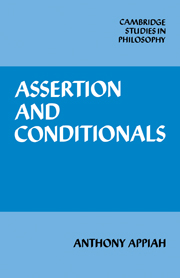3 - Belief and decision
Published online by Cambridge University Press: 07 October 2011
Summary
In order therefore to construct a theory of quantities of belief … I propose to take as a basis a general psychological theory … I mean the theory that we act in the way we think most likely to realise the objects of our desires.
(Ramsey, 1978:75)OVERVIEW
The last chapter ended by listing 11 of the principal demands I claim functionalism makes of a theory of the mind. In this chapter I set about developing an account of belief that has grown up with functionalism, trying, as I go, to adjust it to those demands.
We can begin with a simple observation: belief comes by degrees. I believe more strongly that it will rain tomorrow than that President Carter will win the United States Presidential election in 1988. Our language is full of idioms that allow us to express the relative strengths of our beliefs. We say we think one thing more likely than another; or that we have more confidence that one thing will happen than another; or that we think something extremely likely or are highly confident that it will happen. And such differences in the strengths of our beliefs show up not only in what we say, but in what we do. People who believe only fairly strongly that aeroplanes are safe need a stronger motive for flying than they would if they had more confidence in them.
- Type
- Chapter
- Information
- Assertion and Conditionals , pp. 39 - 72Publisher: Cambridge University PressPrint publication year: 1985



